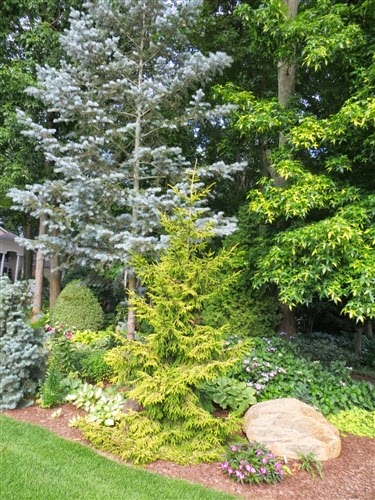The garden discussed in the article is in St. Louis, Missouri, a very different growing environment (USDA Zone 6a) with many more stressors than Portland, Ore. (USDA 8a in my neighborhood); however, it seems there are quite a number of genus and species that might be worth trying.
“Some types of acceptable shade for growing conifers are filtered shade, dappled shade, traveling shade, light shade and high canopied shade. Generally speaking, there is more light available in shady spots than gardeners realize,” concluded the authors Bruce and Chick Buehrig. More hope for me and my garden.
Tsuga canadensis (hemlocks) are a good place to start. I have several planted, including T.c. ‘Gentsch White’. They live but I wouldn’t say they thrive, and in full shade ‘Gentsch White’ doesn’t have the showy white new growth it is known for. Other Tsuga cultivars mentioned in the article include ‘Stewart’s Gem’, ‘Curly’, ‘Canoe’, ‘Spring Glory’, ‘Greenbrier’, ‘Devil’s Fork’, ‘New Gold’ and the list goes on.
Picea orientalis (Oriental spruce) cultivars to consider include ‘Skylands’, ‘Bergman’s Gem’, ‘Connecticut Turnpike’, ‘Repens’, ‘Gowdy’, and ‘Shadow Broom’. I’m going to keep my eye out for ‘Skylands’; it offers year-round golden needles.
 |
| Picea orientalis 'Skylands'. Photo courtesy of Conifer Kingdom |
Taxus (yews), especially the columnar varieties which add height are good candidates for adding interest in a shadier spot. Look for ‘Beanpole’, ‘Stovepipe’, ‘David’, ‘Minuet’, ‘Citation’, ‘Erecta’, ‘Standishii’ and ‘Sentinel’, the authors’ favorite (I’m guessing they are referring to Taxus x media ‘Sentinalis’). ‘Flushing’ and ‘Maureen’ which reach ten feet tall by two feet wide can be focal points. ‘Citation’ is also a favored addition to their landscape.
Cephalotaxus (plum-yew) thrive in more shade. Look for ‘Duke Gardens’, ‘Fastigiata’, ‘Hedgehog’ and ‘Korean Gold’.
 |
| Cephalotaxus harringtonia 'Korean Gold'. Photo courtesy of Oreogn State University. |
 |
| Chamaecyparis nootkatensis 'Van den Akker'. Photo courtesy of Dancing Oaks Nursery. |
Perhaps not all of these species and cultivars will thrive in the shade of the Maritime Northwest—after all, St. Louis has much warmer and moister summers than we do—but it does suggest that there may be a few more conifers that can add year round interest in our gardens, even in shadier conditions.
Sources for more unusual conifers, in addition to your local garden center, include Conifer Kingdom, Oregon Small Trees, Dancing Oaks, Forestfarm, Porterhowse Farms, River Rock Nursery and Secret Garden Growers.


No comments:
Post a Comment